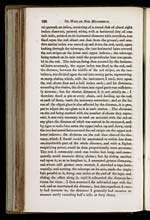James Watt (1736-1819)
Account of micrometers for measuring distances
122
Mr Watt on New Micrometers.
vel ground, an index, consisting of a round disk of about eight
inches diameter, painted white, with a horizontal line of one
inch wide, painted on its horizontal diameter with vermilion, was
fixed upon the rod about one foot from the ground, and ano-
ther similar index was moved up and down the rod, until, upon
looking through the telescope, the two horizontal hairs covered
the red stripes on the lower and upper indexes; the telescope
being turned on its axis until the perpendicular hair was paral-
lel to the rod. The indexes being thus covered by the horizon-
tal hairs accurately, the upper index was fixed to the rod, and
the distance, between the middle of the red stripes, on the two
indexes, was divided upon the rod into twenty parts, representing
so many chains, which, with the instrument I used, were upon
the rod about four and a half inches each; and for distances,
exceeding five chains, this division into equal parts was sufficient-
ly accurate; but for shorter distances it is not strictly so. I
therefore fixed a pin at every chain, and holding up the rod
at each of them, made the necessary correction; and as the fo-
cus of the object-glass is also affected by the distance, it is pro-
per to adjust the eye-glass to it at each station. The divisions
on the rod being marked with the number of chains they repre-
sent, it was only necessary to send an assistant with the rod to
any place the distance of which was wanted to be measured, and
by signs to make him move the upper index up and down, until
the two horizontal hairs covered the red stripes on the upper and
lower indexes; the divisions on the rod then showed the dis-
tance, which I found could be ascertained to within less than
one-hundredth part of the whole distance, and with a higher
magnifying power, could be done proportionally more accurate.
The rod I commonly used was twelve feet long, and conse-
quently could measure thirty chains; but by sliding another
rod upon it, so as to lengthen it, I measured greater distances,
and where still greater were wanted, I stretched a tape hori-
zontally, and turning the telescope on its axis, made the single
hair parallel to it, fixing one index at the end of the tape, and
sliding the other along it, until it subtended the distane be-
tween the wires. I then measured the subtended tape with the
rod, and so ascertained the distance; but this expedient I rare-
ly had recourse to, the distances I generally had occasion to
measure rarely exceeding half a mile, or forty chains.


